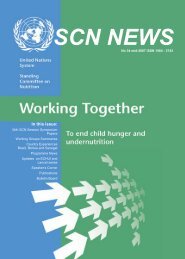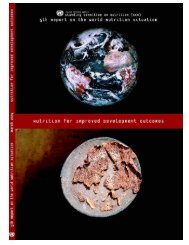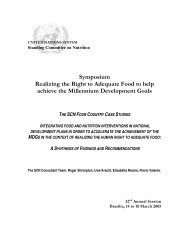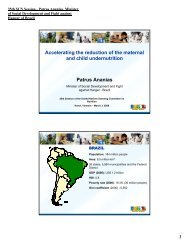Universal Salt Iodization (USI) - FTP Directory Listing
Universal Salt Iodization (USI) - FTP Directory Listing
Universal Salt Iodization (USI) - FTP Directory Listing
- No tags were found...
Create successful ePaper yourself
Turn your PDF publications into a flip-book with our unique Google optimized e-Paper software.
30FEATURESwww.unsystem.org/scnleaders, who had collected more than $8,000 for the IDD cause (Anonymous 2000). Sir Edmund Hillarypromoted the Kiwanis campaign in New Zealand and Australia. As the project gained momentum, Kiwanisleaders began to realize that a large number of players were working to achieve universal salt iodization(<strong>USI</strong>). Above all, they learned the important role of salt producers in eliminating IDD.The Worldwide Service Project—with its grand vision and lofty goal and the experience of all clubs working toachieve a common objective—energized and united the members. This, perhaps, is the programme’s mostlasting legacy to the entire Kiwanis organization (Blechman 1994). However, in addition it introduced thename “Kiwanis” to many countries that had not previously been aware of it.Kiwanis partners with UNICEFThough Kiwanis clubs exist in more than 70 nations, much of its membership lived in areas not affected byiodine deficiency. Nor did Kiwanis leaders have the scientific, marketing and public health expertise toimplement IDD-prevention programmes in endemic areas. Therefore, Kiwanis relied on UNICEF experts towork with salt producers, various government ministries, national government officials, nongovernmentalorganizations, schools and others to develop a country plan for the elimination of IDD. These UNICEFapprovedproposals included detailed budgets and timetables, which were submitted to Kiwanis Internationalfor consideration. An allocations committee, made up of officers of both Kiwanis International and KiwanisInternational Foundation, made funding recommendations after review of each proposal. Once a proposalhad been approved, the requested funds were transferred to UNICEF. It is important to note that, byagreement, all Kiwanis funds were used to support approved projects; no money was retained by UNICEFheadquarters or its various country committees for administration or other uses.Kiwanis received regular progress reports from UNICEF. In addition, Kiwanis leaders conducted on-sitereviews with UNICEF staff members in a number of countries. Often the visiting Kiwanians met withgovernment leaders to reinforce the value of the countries’ IDD-reduction efforts.Key Club International partnered with the US Fund for UNICEF to conduct annual Trick-or-Treat for UNICEFprogrammes to raise money for the Kiwanis organization’s Worldwide Service Project. Key Club and USFund continue their relationship to fund other global causes, such as HIV/AIDS in Africa.Despite the clubs' strong traditions in serving only the needs of their communities, support of the WorldwideService Project advanced steadily and the fight against IDD became immensely popular among club leaders.By 2002, the Worldwide Service Project for IDD elimination had reached its US$75 million goal and Kiwanishad contributed more than US$60 million to the national IDD elimination programmes in 90 countries throughUNICEF. Along the way, Kiwanis built partnerships with salt producers, the International Council for theControl of Iodine Deficiency Disorders (ICCIDD), the World Health Organization (WHO), the MicronutrientInitiative (MI) and other organizations. These achievements firmly established Kiwanis International as aninternational service organization for children and the name of Kiwanis and its contributions to promoteuniversal salt iodization became known throughout the world.The scale of this global effort and the reporting of UNICEF provided Kiwanis the opportunity to monitor theeffectiveness of its contributions and to report progress to Kiwanis leaders and Kiwanis supporters. Theability of members and their supporters to see the results being achieved by their contributions was vital tothe continued success of the Kiwanis campaign (Blechman 1994).Engaging Kiwanis’ global membershipAs the campaign gained momentum among the membership, Kiwanis International supplemented its printedcampaign materials with videos, convention forums and eyewitness reports that proved to the members thesignificance of their support. Meetings were conducted at every level to educate Kiwanis leaders and theirsupporters of the problems associated with IDD, how it could be eliminated and how Kiwanis Internationalwould lead the international effort. They were shown how Kiwanis funds, Kiwanis advocacy and Kiwanishands-on efforts could help change the world forever.Kiwanis leaders visited countries that had suffered from IDD but were now benefiting from Kiwanis’ support.SCN NEWS # 35 back to contents







